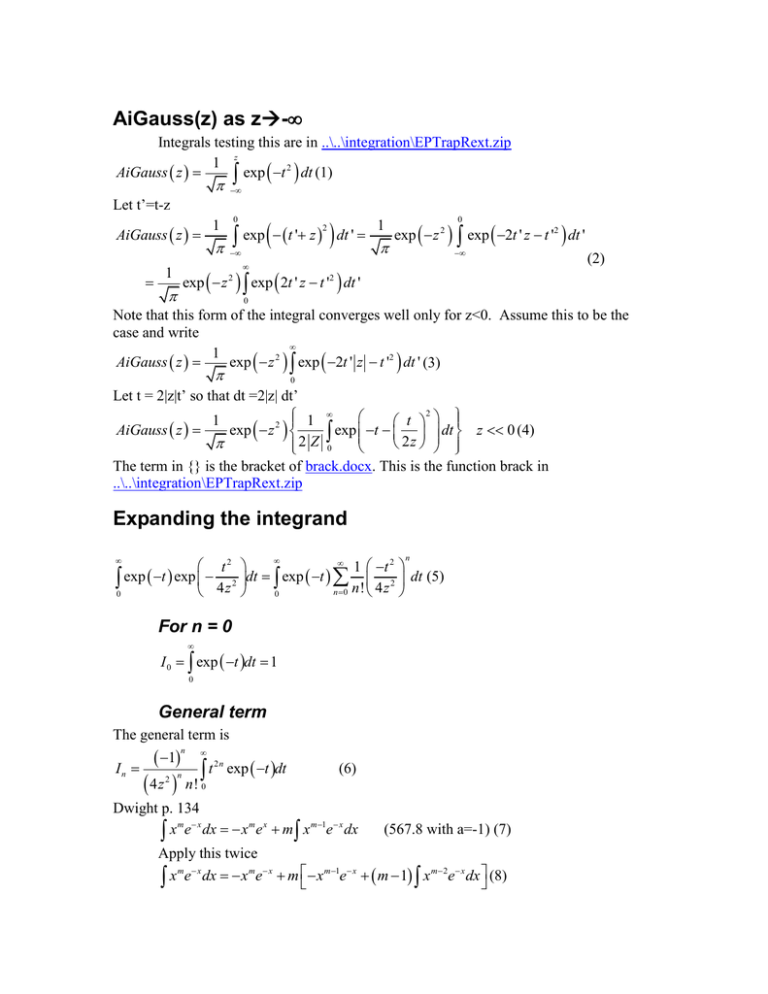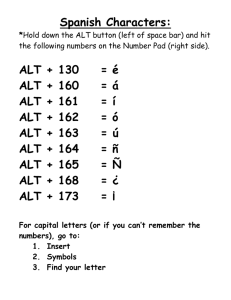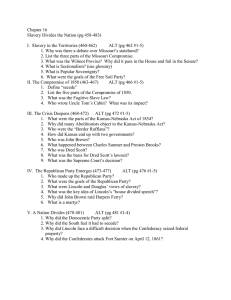advertisement

AiGauss(z) as z-
Integrals testing this are in ..\..\integration\EPTrapRext.zip
z
1
2
AiGauss z
exp t dt (1)
Let t’=t-z
exp t ' z dt '
exp z
1
0
1
AiGauss z
2
1
0
exp z 2 exp 2t ' z t '2 dt '
2
exp 2t ' z t ' dt '
(2)
2
0
Note that this form of the integral converges well only for z<0. Assume this to be the
case and write
1
2
AiGauss z
exp z exp 2t ' z t '2 dt ' (3)
0
Let t = 2|z|t’ so that dt =2|z| dt’
2
1
t
2 1
AiGauss z
exp z
exp t dt z 0 (4)
2 z
2 Z 0
The term in {} is the bracket of brack.docx. This is the function brack in
..\..\integration\EPTrapRext.zip
Expanding the integrand
n
t2
1 t 2
exp
t
exp
dt
exp
t
2 dt (5)
0 4 z 2 0
n0 n ! 4 z
For n = 0
I 0 exp t dt 1
0
General term
The general term is
In
1
4z
n
2 n
t
n!
2n
exp t dt
(6)
0
Dwight p. 134
m x
m x
m 1 x
x e dx x e m x e dx
(567.8 with a=-1) (7)
Apply this twice
m x
m x
m 1 x
m 2 x
x e dx x e m x e m 1 x e dx (8)
Change m to 2n and x to t
t
e dx t 2 n et 2n t 2 n 1et 2n 1 t 2 n 1et dx
2n x
(9)
e dx
For the integration range 0 to the leading term is zero for n > 0. Thus
t 2 n 2nt 2 n 1 et 2n 2n 1 t
2n x
t e dx 2n 2n 1 t
0
2 n 1 t
e dt
2 n 1 t
n 0 (10)
0
So that
In
1
4z
n
2 n
t
n!
2n
exp t dt
0
1
n
2n 2n 1
4z
2 n
n!
t
2 n 1
exp t dt
0
(11)
1
I n 1
t 2 n 1 exp t dt
2 n 1
4 z n 1! 0
n 1
Putting the integral in terms of In-1 by subsituting In-1 for the integral
In
1
n
2n n 1 4 z 2
n 1
4 z n! 1
2 n
2n 1
2n 1!
n 1
I n 1
(12)
I n 1
2z2
This series has asymptotic convergence, for large |z| it decreases at first, but eventually
the n dominates and the sum oscillates between + and – large numbers. Writing the terms
out
I0 1
1
2z2
3
3 (13)
I 2 2 I1
2z
2 2z4
5
15
I3 2 I 2 3 6
2z
2 z
For z = 1, the terms are I1=-.5, I2 = .75, I3 = 1.875
ENTER X
M, ALT
1
0.500000000000000
M, ALT
3
0.750000000000000
M, ALT
5
1.875000000000000
These are the same as the terms in Dwight 592. Dwight says that the error is less than the
last term used [ref 91, p 390]
I1
1
Advancd Calculus, by E.B. Wilson; Ginn & Co., Boston, 1912
2
e x
2!
4!
6!
erf x
e dt 1
1
2
4
6
0
x 1! 2 x 2! 2 x 3! 2 x
true for x > 0
2
x
t 2
(592.) Must be only
Alternatively the bracket can be written as
1
1 3 1 3 5
1 2 2 4 3 6
2x
2 x
2 x
For x = 10 and a last term of 10
10x9x8x7x6/(20)10=2.953125x10-9
For x = 10 and a last term of 20
20x19x18x17x16x15x14x13x12x11/2020= 6.393838623046875x10-15
The asymptotic expansion reaches 10-15 accuracy only for x > 6
The code is in aigzm.zip
Tbrack TBRACK.FOR
IMPLICIT REAL*8 (A-H,O-Z)
PRINT*,' ENTER X '
READ(*,*)X
FUN=BRACK(X)
PRINT*,' FUN = ',FUN
GOTO 5
END
C$INCLUDE BRACKET
5
Bracket bracket.for
FUNCTION BRACK(X)
IMPLICIT REAL*8 (A-H,O-Z)
BRACK=1
XP=1
X2=X*X
ANUM=1
IS=-1
M=1
DEN=2*X2
ALT=1
5
CONTINUE
ALT=ALT*M/DEN
PRINT*,' M, ALT ',M,ALT
M=M+2
BRACK=BRACK+IS*ALT
IS=-IS
IF(ALT.GT.1D-15)GOTO 5
RETURN
END
C:\temp>tbrack
ENTER X
6
M, ALT
1
0.0138888888888889
M, ALT
3
0.0005787037037037
M, ALT
5 4.0187757201646090D-005
M, ALT
7 3.9071430612711480D-006
M, ALT
9 4.8839288265889340D-007
M, ALT
11 7.4615579295108720D-008
M, ALT
13 1.3472257372727960D-008
M, ALT
15 2.8067202859849930D-009
M, ALT
17 6.6269784530201210D-010
M, ALT
19 1.7487859806580880D-010
M, ALT
21 5.1006257769194220D-011
M, ALT
23 1.6293665676270380D-011
M, ALT
M, ALT
M, ALT
M, ALT
M, ALT
M, ALT
M, ALT
M, ALT
M, ALT
M, ALT
M, ALT
M, ALT
M, ALT
M, ALT
M, ALT
M, ALT
FUN =
ENTER X
100
M, ALT
M, ALT
M, ALT
M, ALT
FUN =
ENTER X
25 5.6575228042605480D-012
27 2.1215710515977050D-012
29 8.5452167356018690D-013
31 3.6791905389396930D-013
33 1.6862956636806930D-013
35 8.1972705873367010D-014
37 4.2124862740480270D-014
39 2.2817633984426810D-014
41 1.2993374907798600D-014
43 7.7599322366019430D-015
45 4.8499576478762150D-015
47 3.1659445756969730D-015
49 2.1546011695715510D-015
51 1.5261758284465160D-015
53 1.1234349848286850D-015
55 8.5817950229969010D-016
0.9866531092311659
note these terms just barely converge
1 5.0000000000000000D-005
3 7.5000000000000010D-009
5 1.8750000000000000D-012
7 6.5625000000000020D-016
0.9999500074981257
The complete value of Aigauss
Equation (4) in these terms is
1
AiGauss z
exp z 2 Brack ( z ) z 0 (14)
2z
For 15 digit accuracy z must be less than –5.91. The code in aigzm.zip is AIGZM.FOR
with test calls in TAIGSM.FOR
The bracket desired for fitting is Brack(z)/(2|z|)
Consider the second function
t2
t
exp 2 f x
2z
4z
For x =0, the function is 1, for x=4 the function is exp(-16)
IMPLICIT REAL*8 (A-H,O-Z)
H=6D0/1000
OPEN(1,FILE='FUNC.OUT')
DO I=1,1000
X=(I-.5D0)*H
ARG=X*X
FUNC=EXP(-ARG)
WRITE(1,'(2G15.6)')X,FUNC
ENDDO
END
Information Sampling
Write the integral in (4) as
t 2
I z exp t exp dt exp t f t , z dt
2z
0
0
(15)
2
t
f t , z exp 1 t
2 z
Let
t
1 exp t
y exp x dx
0
t
1
ln 1 y
(16)
1
dy exp t y dy
1 y
So that
dt
1
I z
1/
f t y , z dy
0
(17)
Numerically
For y=1/α, t=ln(1- α 1/α)/α=∞
Computers do not handle ∞ very well. In order to leave a few digits for the
last term the ending point for the integral in (17) is actually ymax = (1-1013)/α. This means that the integration in t extends only to 13*2.3/α.
The first and third partials of the integrand in (17) with respect to y are needed
t
1
y 1 y
2t
(18)
2
2
y
1
y
3t
2 2
y 3 1 y 3
f t y
y
f t y
2
y 2
3 f t y
y 3
f t t
(19)
t y
2 f t t f 2 t y
(20)
t y 2
t 2
y
2
2 f t t 2 t
3 f t
3 3
2
t
t 2
y
y y
3
3
f t y
(21)
3
t y
Figure 1 The black squares are for 100 data points. The colored squares increase this to 400.





